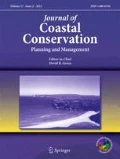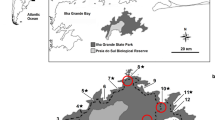Abstract
For a non-native plant to become invasive in a new area where it was introduced it has to establish and maintain self-sustaining populations with plants that survive and reproduce at significant distance from the original point of introduction. Here, we searched for locations with the occurrence of a non-native palm and use historical attributes to infer their introduction date on an island in Atlantic Forest. We checked all existing trails, inhabited and semi-deserts areas on the island and detected seven sites where the non-native palm was present. We found a large number of adult palms in three of these sites, including reproductive palms farther than 100 m from areas different from those they were planted. This indicates that the species is spreading farther from the source populations. We estimated the minimum residence time in 110 years by means of historical records. The results of our study indicate that the species is in the final stage of the invasion process. Therefore, threat abatement measures should be undertaken with urgency, involving local residents. Engaging residents in decision making may increase the success of management programs. Our results also showed the relevance of using historical attributes as a resource in studies on invasive alien species.



Similar content being viewed by others
References
Alho CJR, Schneider M, Vasconcellos LA (2002) Degree of threat to the biological diversity in the Ilha Grande State Park (RJ) and guidelines for conservation. Braz J Biol 62:375–385
Baddeley A, Rubak E, Turner R (2015) Spatial point patterns: methodology and applications with R. Chapman and Hall/CRC Press, London
Blackburn TM, Pysek P, Bacher S, Carlton JT, Duncan RP, Jarosık V, Wilson JRU, Richardson DM (2011) A proposed unified framework for biological invasions. Trends Ecol Evol 26:333–339
Bonadie WA (1998) The ecology of Roystonea oleracea palm swamp Forest in the Nariva swamp (Trinidad). Wetlands 18:249–255
Bucharova A, van Kleunen M (2009) Introduction history and species characteristics partly explain naturalization success of north American woody species in Europe. J Ecol 97:230–238
Callado CH, Barros AAM, Ribas LA, Albarello N, Gagliardi R, Jascone CE (2009) Flora e Cobertura Vegetal. In: Bastos M, Callado CH (eds) O Ambiente da Ilha Grande. Centro de Estudos Ambientais e Desenvolvimento Sustentável, Rio de Janeiro, pp 91–161
Castro SA, Figueroa JA, Munoz-Schick M, Jaksic FM (2005) Minimum residence time, biogeographical origin, and life cycle as determinants of the geographical extent of naturalized plants in continental Chile. Divers Distrib 11:183–191
Charles-Dominique P, Chave J, Vezzoli C, Dubois MA, Riéra B (2001) Growth strategy of the understorey palm Astrocaryum sciophilum in the rainforest of French Guiana. In: Gottsberger G, Liede S (eds) Life forms and dynamics in tropical forests. Berlin, Stuttgart, pp 153–163
Chen C, Wang QH, Wu JY, Huang D, Zhang WH, Zhao N, Li XF, Wang LX (2016) Historical introduction, geographical distribution, and biological characteristics of alien plants in China. Biodivers Conserv 26:353–381
Collonello G, Allende JRG, Molina IM (2016) Roystonea oleracea (Arecaceae) communities in Venezuela. Bot J Linn Soc 182:439–450
D’Elboux RMM (2006) Uma promenade nos trópicos: os barões do café sob as palmeiras-imperiais, entre o Rio de janeiro e são Paulo. An Mus Paul 14:193–250
Dean WA (1989) Botânica e a política imperial: introdução e adaptação de plantas no Brasil Colonial e Imperial. Instituto de Estudos Avançados (USP) 17:1–20
Dean WA (1996) A ferro e fogo: a história da devastação da Mata Atlântica. Cia das Letras, São Paulo
Feng Y, Maurel N, Wang Z, Ning L, Yu FH, van Kleunen M (2016) Introduction history, climatic suitability, native range size, species traits and their interactions explain establishment of Chinese woody species in Europe. Glob Ecol Biogeogr 25:1355–1366
Fernandes GW, Vale MM, Overbeck GE et al (2017) Dismantling Brazil’s science threatens global biodiversity heritage. Perspect Ecol Conserv 15(3):239–243
Gerson B (1965) Histórias das ruas do Rio. Livraria Brasiliana, Rio de Janeiro
Harris CJ, Murray BR, Hose GC, Hamilton MA (2007) Introduction history and invasion success in exotic vines introduced to Australia. Divers Distrib 13:467–475
Henderson A, Galeano G, Bernal R (1995) Field guide to the palms of the Americas. Princeton University Press, Princeton
INEA – Instituto Estadual do Ambiente (2013) Parque Estadual da Ilha Grande: plano de manejo, Rio de Janeiro
Instituto Hórus de Desenvolvimento e Conservação Ambiental (2018) Brazil Database of Invasive Alien Species. http://i3n.institutohorus.org.br/www. Accessed 08 Oct 2018
Johnson DV (1976) Palm longevity. Principes 20:70–71
Lorenzi H, Souza HM, Costa JTM, Cerqueira LSC, Ferreira E (2004) Palmeiras brasileiras e exóticas cultivadas. Nova Odessa, São Paulo
Mack MC, D’Antonio CM (1998) Impacts of biological invasions on disturbance regimes. Trends Ecol Evol 13:195–198
Mack RN, Simberloff D, Lonsdale WM, Evans H, Clout M, Bazzaz FA (2000) Biotic invasions, causes, epidemiology, global consequences, and control. Ecol Appl 10:689–710
Mello CEHV (1987) Apontamentos para servir à história fluminense: Ilha Grande, Angra dos Reis. Conselho Municipal de Cultura, Angra dos Reis
Meyer JY, Lavergne C, Hodel DR (2008) Time bombs in gardens: invasive ornamental palms in tropical islands, with emphasis on French Polynesia (Pacific Ocean) and the Mascarenes (Indian Ocean). Palms 52:23–35
Moody ME, Mack RN (1988) Controlling the spread of plant invasions - the importance of nascent foci. J Appl Ecol 25:1009–1021
Nascimento MT, Araújo RM, Dan ML, Netto EBF, Braga JMA (2013) The imperial palm (Roystonea oleracea (Jacq.) O.F. Cook) as an invasive species of a wetland in Brazilian Atlantic forest. Wetl Ecol Manag 21:1–5
Oliveira RR (2002) Ação antrópica e resultantes sobre a estrutura e composição da Mata Atlântica na Ilha Grande. RJ Rodriguésia 53:33–58
Oliveira AR, Teixeira ML, Reis R (2009) As palmeiras-imperiais do Jardim Botânico. Dantes Editora, Rio de Janeiro
Overbeck GE, Bergallo HG, Grelle CE, Akama A, Bravo F, Colli GR, Magnusson WE, Tomas WM, Fernandes GW (2018) Global biodiversity threatened by science budget cuts in Brazil. BioScience 68(1):11–12
Pysek P, Manceur AM, Alba C, McGregor KF, Pergl J, Stajerova K, Chytry M, Danihelka J, Kartesz J, Klimesova J, Lucanova M, Moravcova L, Nishino M, Sadlo J, Suda J, Tichy L, Kuhn I (2015) Naturalization of central European plants in North America: species traits, habitats, propagule pressure, residence time. Ecology 96:762–774
Raíces DSL, Ferreira PM, Mello JHF, Bergallo HG (2017) Smile, you are on camera or in a live trap! The role of mammals in dispersion of jackfruit and native seeds in Ilha Grande State Park, Brazil. Nat Conserv Res 2:78–89
Rejmánek M (2000) Invasive plants: approaches and predictions. Aust Ecol 25:497–506
Rejmánek M, Richardson DM (1996) What attributes make some plant species more invasive? Ecology 77:1655–1660
Richardson DM, Rejmánek M (2011) Trees and shrubs as invasive alien species-a global review. Divers Distrib 17:788–809
Richardson DM, Pyšek P, Rejmánek M, Michael GB, Panetta FD, West CJ (2000) Naturalization and invasion of alien plants: concepts and definitions. Divers Distrib 6:93–107
Rodrigues JB (1893) Hortus Fluminensis. Leuzinger, Rio de Janeiro
Sakai AK, Allendorf FW, Holt JS, Lodge DM, Molofsky J, With KA, Baughman S, Cabin RJ, Cohen JE, Ellstrand NC, McCauley DE, O’Neil P, Parker MI, Thompson JN, Weller SG (2001) The population biology of invasive species. Annu Rev Ecol Syst 32:305–332
Sarthou C (1965) Relíquias da cidade do Rio de Janeiro. Atheneu, Rio de Janeiro
Sharp RL, Larson LR, Green GT (2011) Factors influencing public preferences for invasive alien species management. Biol Conserv 144:2097–2104
Simberloff D, Martin JL, Genovesi P, Maris V, Wardle DA, Aronson J, Courchamp F, Galil B, Garcia-Berthou E, Pascal M, Pysek P, Sousa R, Tabacchi E, Vilà M (2013) Impacts of biological invasions: what’s what and the way forward. Trends Ecol Evol 28:58–66
Svenning JC (2002) Non-native ornamental palms invade a secondary tropical forest in Panama. Palms 46:81–86
Theoharides KA, Dukes JS (2007) Plant invasion across space and time: factors affecting nonindigenous species success during four stages of invasion. New Phytol 176:256–273
van Kleunen M, Dawson W, Essl F et al (2015) Global exchange and accumulation of non-native plants. Nature 525:100–103
Wilson JRU, Richardson DM, Rouget M, Proches S, Amis MA, Henderson L, Thuiller W (2007) Residence time and potential range: crucial considerations in modelling plant invasions. Divers Distrib 13:11–22
Wu SH, Chaw SM, Rejmánek M (2003) Naturalized Fabaceae (Leguminosae) species in Taiwan: the first approximation. Bot Bull Acad Sin 44:59–66
Zenni RD, Dickie IA, Wingfield MJ, Hirsch H, Crous CJ, Meyerson LA, Burgess TI, Zimmerman TG, Klock MM, Sieman E, Erfmeier A, Aragon R, Moniti L, Le Roux JJ (2017) Evolutionary dynamics of tree invasions following the unified framework for biological invasions. AoB Plants 9:plw085
Zona S (1996) Roystonea (Arecaceae: Arecoideae). Flora Neotropica 71:1–35
Zucaratto R, Pires AS (2014) The exotic palm Roystonea oleracea (Jacq.) O. F. Cook (Arecaceae) on an island within the Atlantic Forest Biome: naturalization and influence on seedling recruitment. Acta Bot Bras 28:417–421
Acknowledgements
This study was financed in part by the Coordenação de Aperfeiçoamento de Pessoal de Nível Superior - Brasil (CAPES) - Finance Code 001. HGB thanks FAPERJ Research Grants (CNE-26/202.757/2017), CNPq (307781/2014-3) and Prociência/UERJ. We also thank the Center for Environmental and Sustainable Development Studies (CEADS) and the Rio de Janeiro State Institute for the Environment (INEA) for logistical support. Dr. Silvia Ziller gave an important improvement to the manuscript.
Author information
Authors and Affiliations
Corresponding author
Additional information
Publisher’s note
Springer Nature remains neutral with regard to jurisdictional claims in published maps and institutional affiliations.
Rights and permissions
About this article
Cite this article
Zucaratto, R., Santos, G.S., dos Santos Pires, A. et al. Coalescing past and present to predict the future: historical attributes and current situation of a non-native palm on an island in the Atlantic Forest. J Coast Conserv 24, 20 (2020). https://doi.org/10.1007/s11852-020-00738-8
Received:
Revised:
Accepted:
Published:
DOI: https://doi.org/10.1007/s11852-020-00738-8




